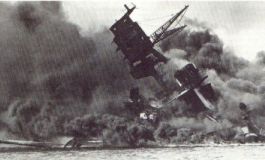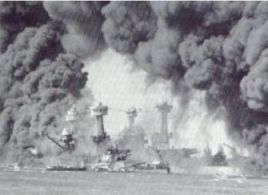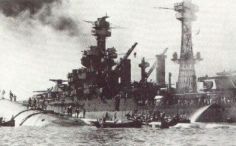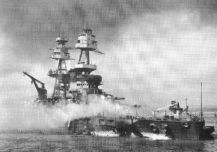|
The USS Nevada sat helplessly on the bottom at the forks in channel. She had bravely tried to get out of Pearl Harbor but succumbed to the many bomb and torpedo hits and had to run herself
aground so she wouldn’t block the main channel and prevent other ships from getting in or out.
Looking into the eyes of shipmates you could detect a determination and resolve to fight back and hold the line. Besides the ships damaged and sunk in Pearl Harbor we knew that Wake, Guam, Midway and the Philippines were also attacked. Japanese submarines were deployed all around the Hawaiian Islands and some ships had been torpedoed between Honolulu and San Francisco. As we neared the mouth of the channel we picked up speed to about 20 knots and continued to accelerate in the open sea as a defensive measure against any lurking enemy submarines.
We spent a lot of time at general quarters on submarine alerts. It appeared most was real and the Task Force sank or damaged a number of them. Some times it turned out to be a black fish or some other debris. The seas were rough and stormy most of the time and we returned to Pearl Harbor December 16th 1941.
The rumor was going around we would try to relieve besieged Wake Island; however news was received that its gallant defenders sank a Japanese destroyer, shot down a number of aircraft and repelled 14 separate attacks but finally fell to a much larger Japanese Force.
Announcements were made that Japanese submarines shelled Hilo, Hawaii: Kahului, Maui and Nawiliwili, Kauai. Hawaiians on the remote island Niihau near Kauai killed some downed Japanese airmen after being terrorized for more than a week. Japanese Submarines sank the freighter Lahaina and Prusa. Martial law was now in effect throughout the Hawaiian Islands and Admiral Chester W. Nimitz was now the new commander of the Pacific Fleet. Scuttlebutt or rumors were also going around about getting ready for a landing attempt by Japanese ground forces, other Navy ships like the carrier USS Lexington and cruiser USS Pensacola being sunk etc.
We left Pearl Harbor on our second patrol December 19th 1941 to cover the reinforcement of Midway and make a sweep west towards Wake and Guam. The carrier Enterprise, weather permitting, sent out airplanes from dawn to dusk to patrol for any sign of the enemy. Aircrews not on patrol practiced strafing and bombing of a target towed by some other ship in the Task Force. All hands were at battle stations one hour before daylight till one hour after every morning. Gun crews often stayed at their battle-stations for off-set surface gunnery practice or one of the Scout Observation planes from the Salt Lake City would tow a target sleeve for Anti-Aircraft gunners to sharpen their skills. If we weren’t at battle-stations we drilled to improve our combat skills or were assigned to a work detail to do housekeeping and maintenance duties. Leisure time was non existent and you often slept on the deck near your battle-station with your lifejacket for a pillow.
We celebrated Christmas on the other side of the International Date Line on full alert but our cooks and bakers managed to feed everyone, in shifts, a complete Christmas dinner. The chaplain was equally as busy administering the religious requirements of all crewmembers. That night we crossed back across the International Date Line for a second Christmas, which we celebrated with another full dinner and the chaplain again enthusiastically, administered the religious requirements of all faiths.
The second war patrol of the Swayback Maru was much the same as the first. We spent a lot of time at our battle-stations on submarine alerts. If a lookout spotted something that could be a torpedo wake or periscope, the nearest gun would shoot at it and a Destroyer or Scout Observation Plane on patrol around the Task Force would head for that spot at high speed. The Destroyer would lock on with its sonar followed by a depth charge attack. If it turned out to be some debris or fish you soon learned what it was. One day one of our 5 inch AA gun crews on the starboard side spotted something sticking up like a periscope going by and fired a round to mark its location. A Destroyer came over immediately and identified it as a swab, or mop, with its handle sticking straight up. It evidently was lost overboard by someone that didn’t tie the mop on the line well enough before they threw it over the side for cleaning by dragging it through the water.
A few days prior to returning to Pearl Harbor the Captain gave us one of his talks on the loudspeaker. Captain Zacharias often gave us talks about what was going on in the rest of the world, what we were doing and might expect. He had spent a long time on Embassy duty in Japan, could speak Japanese fluently and knew the Japanese people very well. He was one of the early Japanese code breakers, and became Assistant Chief of Naval Intelligence upon leaving the Swayback Maru in May 1942. Later he acted as the Radio spokesman during diplomatic negotiations that preceded the Japanese surrender. Due to his leadership and the respect of the entire crew we soon settled down and began to look like a well-trained combat team.
During this talk he complimented everyone for the manner which they were performing their duties to protect the USS Enterprise, the ship we were escorting. Although we have been reporting things like mop handles sticking out of the water or other debris, that is the way to do it. Don’t feel like your seeing and reporting too much, a mop may turn out to be a Submarine. Every report must be investigated and with each report we are acting more calmly each time and doing the job that is required of us. Doing so will result in successfully defeating the enemy. You have had time to talk over the things you saw at Pearl Harbor. I suggest that put it in the past and concentrate on the enormous task now before us, as there is much to be done. It will not be a short war.
We returned to Pearl Harbor December 31,1941 and was fitted with Radar and four 1.1 quad mount Pom Pom Anti Aircraft Guns. The Marine detachment was assigned to man the two forward guns. The 5th and 6th division was assigned gun #3 and #4 aft. I was assigned as a first loader on #1 gun of quad mount #3 on the starboard side of the fantail. The crew and Navy Yard workman were busy all over the ship making repairs, adding new equipment, repairing and testing old equipment and taking on supplies for our next war cruise.
The war news was not good. Tokyo announced that 1,235 American prisoners taken at Wake Island arrived in Yokohama. This includes many from Hawaii, both armed forces and civilian workers. Japanese troops entered Manila and Hawaii defenses are placed under the unified command of Admiral Chester W. Nimitz.
|



